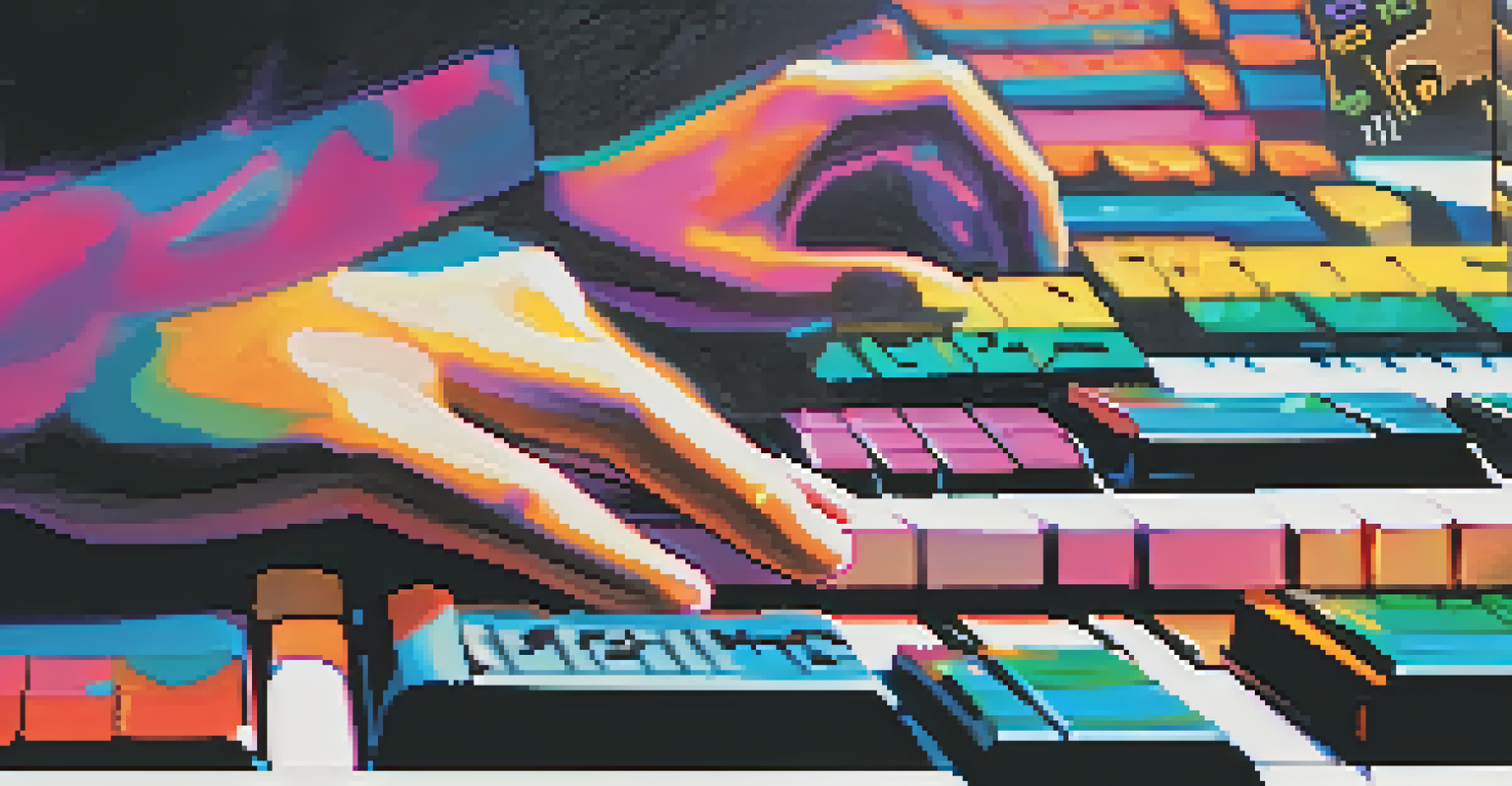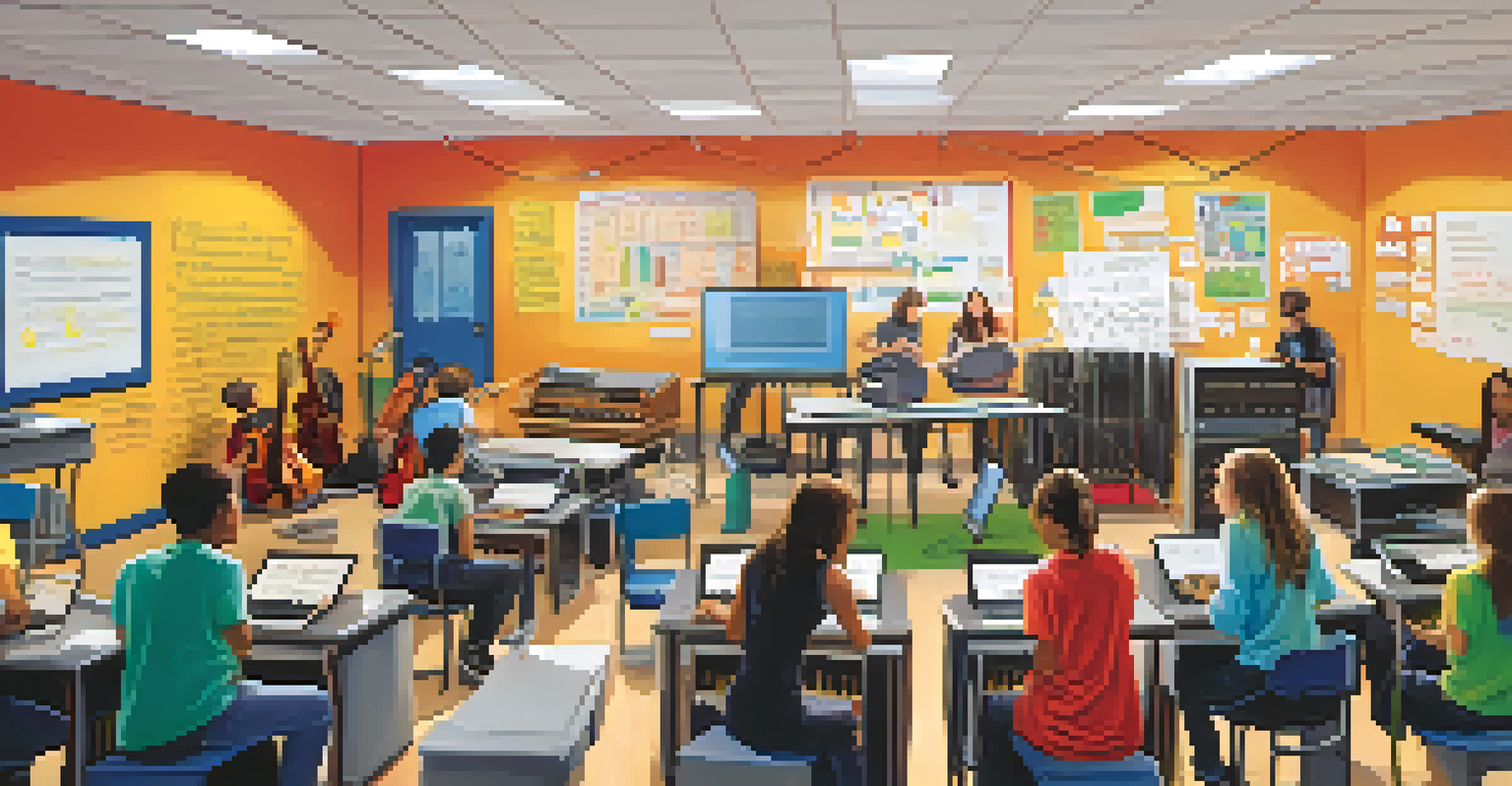Exploring Interactive Music Notation for Modern Composers

Understanding Interactive Music Notation
Interactive music notation refers to digital sheet music that allows composers to engage with their scores in dynamic ways. Unlike traditional notation, where the score is static, interactive notation can respond to user inputs, making it a more immersive experience. This technology bridges the gap between composition and performance, allowing musicians to explore their creativity without the limitations of paper.
Music is the shorthand of emotion.
For example, imagine being able to click on a note and instantly hear how it sounds within the context of the entire piece. This feature not only aids in composing but also helps in understanding how changes in one part affect the whole composition. As technology evolves, composers are finding new ways to utilize these tools to refine their craft.
Ultimately, interactive music notation is reshaping how modern composers approach their work, making the composition process more intuitive and enjoyable. It invites experimentation and encourages musicians to explore sound in innovative ways, setting the stage for a new era in music creation.
Benefits of Interactive Notation for Composers
One of the standout benefits of interactive music notation is its ability to facilitate real-time feedback. Composers can instantly hear changes as they make adjustments to their scores, leading to a more efficient creative process. This immediacy allows for a fluid exchange between writing and revising, which can often lead to unexpected and exciting musical developments.

Additionally, these platforms often come equipped with various tools that allow composers to visualize their music in different ways. From highlighting chord progressions to analyzing rhythms, these features can provide insights that might be overlooked in traditional notation. It's like having a personal assistant that helps you uncover new layers in your compositions.
Interactive Notation Enhances Creativity
Interactive music notation allows composers to experiment and receive real-time feedback, making the creative process more dynamic and efficient.
Moreover, interactive notation fosters collaboration among musicians. With cloud-based platforms, multiple users can access and edit scores simultaneously, making it easier for ensembles to work together regardless of their physical location. This democratization of music creation opens doors for creativity and innovation, encouraging a more collaborative musical landscape.
Popular Tools for Interactive Music Notation
There are several tools available that cater to the needs of modern composers seeking interactive music notation. Programs like MuseScore and Noteflight offer user-friendly interfaces that let composers create, edit, and share their works easily. These platforms often include playback features, enabling users to hear their compositions as they develop them.
The beautiful thing about learning is that no one can take it away from you.
For those looking for more advanced options, software like Dorico and Sibelius provides robust capabilities for intricate compositions. These tools allow for detailed notation, making them ideal for serious composers who require precision in their scores. Such options demonstrate that there's an interactive tool suitable for every level of composer.
Additionally, many of these applications are now cloud-based, meaning that composers can access their work from anywhere, at any time. This flexibility is vital in today’s fast-paced world, where inspiration can strike at any moment. By leveraging these tools, composers can embrace spontaneity and creativity like never before.
Enhancing Learning Through Interactive Notation
Interactive music notation is not just for established composers; it's also a powerful educational tool for students. By engaging with their scores in a dynamic way, learners can grasp complex musical concepts more easily. The ability to hear and visualize music as they compose helps students retain information and fosters a deeper understanding of musical theory.
For instance, students can experiment with scales and chords, immediately hearing how their choices impact the overall sound. This hands-on approach makes learning music theory less intimidating and more enjoyable. It transforms the learning experience from rote memorization to active exploration, making music more accessible.
Collaboration Made Easy
Cloud-based platforms enable multiple musicians to access and edit scores simultaneously, fostering a collaborative musical environment.
Furthermore, educators can utilize interactive notation to create engaging lessons that cater to diverse learning styles. Whether through guided exercises or collaborative projects, these platforms encourage student interaction and creativity. As a result, classrooms become vibrant spaces for musical discovery.
Challenges of Interactive Music Notation
While interactive music notation offers numerous advantages, it also presents certain challenges. One significant hurdle is the learning curve associated with new technology. For some composers, especially those accustomed to traditional methods, adapting to digital tools can be daunting. It requires time and patience to become proficient in navigating these platforms.
Additionally, technical issues can arise, such as software glitches or compatibility problems that can hinder the creative process. These frustrations can be particularly disheartening when a composer is in the flow of inspiration. Therefore, it's essential for users to have a reliable support system to help troubleshoot any issues they may encounter.
Moreover, there's the risk of over-reliance on technology, potentially stifling creativity. When composers become too focused on the features of the software, they might neglect the fundamental elements of music-making. Balancing technology with traditional methods is key to ensuring that the essence of musicality remains at the forefront.
The Future of Interactive Music Notation
The future of interactive music notation looks promising as technology continues to evolve. Innovations in artificial intelligence and machine learning are poised to enhance how composers create and interact with their music. Imagine software that not only plays back scores but also suggests harmonies or orchestrations based on a composer’s style – the possibilities are exciting.
Furthermore, as virtual reality and augmented reality technologies develop, they may offer new ways to experience music notation. These immersive environments could allow composers to visualize their music in three dimensions, transforming how they engage with their scores. Such advancements could lead to entirely new forms of musical expression.
A Valuable Educational Tool
Interactive notation helps students grasp complex musical concepts through hands-on engagement, transforming learning into an enjoyable exploration.
As these technologies emerge, it's crucial for composers to stay informed and adaptable. Embracing change while remaining true to one’s artistic vision will be essential in navigating the future of music composition. Ultimately, interactive music notation is set to continue reshaping the landscape of music, making it more accessible and innovative than ever.
Conclusion: Embracing Interactive Notation
In conclusion, interactive music notation is revolutionizing the way modern composers approach their craft. By allowing for immediate feedback and collaboration, these tools are enhancing the creative process and making music composition more engaging. As composers embrace these innovations, they are not only expanding their own capabilities but also contributing to a vibrant musical community.
While challenges exist, the benefits far outweigh them, making interactive notation an essential asset in today’s musical landscape. It encourages exploration and experimentation, enabling composers to push the boundaries of their creativity. By integrating these tools into their workflow, musicians can unlock new dimensions in their compositions.

As we move forward, it's vital for composers, educators, and enthusiasts alike to embrace interactive music notation. By doing so, we can foster a richer, more diverse musical experience, ensuring that creativity continues to flourish in the digital age.